Pharaoh Hound - August, 2013
The Dogology Featured Breed -
 Dogology brings you reports on selected breeds in order to create an online archive unlike any other. Each breed report will feature multiple photos of the breed in varying situations and will address pertinent information about the breed. Dogology strives to educate not only about breed history and standards, but also on breed care, needs, health, compatability, and what to look for in a breeder when considering selecting this breed for your family. Besides, if you love dogs, these reports are just a plain fun way to find out more about dogs!
Dogology brings you reports on selected breeds in order to create an online archive unlike any other. Each breed report will feature multiple photos of the breed in varying situations and will address pertinent information about the breed. Dogology strives to educate not only about breed history and standards, but also on breed care, needs, health, compatability, and what to look for in a breeder when considering selecting this breed for your family. Besides, if you love dogs, these reports are just a plain fun way to find out more about dogs!
We want you to have as much information as possible when selecting a dog for your family. Whether selecting a pure bred dog or a dog of mixed breed, Dogology Breed Reports will help you understand more about the requirements and commitments needed before bringing your dog to its forever home. If choosing a mixed breed, you can better understand what to expect by reading reports on the predominant breeds that make up your mixed breed dog.
We also hope these reports will help to inspire responsible breeding practices by educating on how responsible breeders operate. It is so important to the future of all our breeds to show financial support to those who take breeding very seriously and who maintain the highest standards for health, adoption and lifetime responsibility of animals. Support of anything less than the highest standards allows breeders to exist who have limited knowledge and who take little to no responsibility in furthering the health, temperament and longevity of the breed. How we choose to get our next dog can also support more humane dog breeding conditions. For example, refusing purchase of dogs from puppy mills will help this irresponsible breeding model to finally collapse. Please use these pages to learn and to choose your next furry friend wisely.
We will be adding new breed reports every few weeks. If you are on our free mailing list, you will be notified when new reports are available. If you would like to see your breed featured, please write us with the contact information for your breed club and the person(s) within the club with whom we should speak or request our Breed Report Form.
Thank you and enjoy,
The Dogology Staff
Pharaoh Hounda Rare Breed
by Emily Kerridge
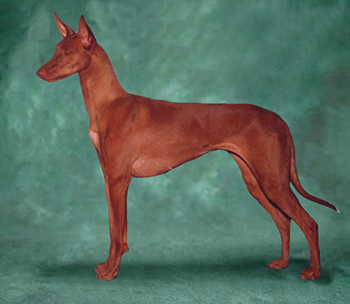 History of the Breed: How, when, and where the breed originated
The Pharaoh Hound is one of the oldest domesticated dog breeds in the world (estimated to have originated around 4000 B.C. As the name implies, the origin of the Pharaoh Hound began in Ancient Egypt. They were used to hunt; chase down small game using their keen eyesight, sense of smell, and acute hearing. Through numerous Egyptian artifacts and writings, we have learned that this unique dog was treasured not only as an adept and able hunter, but also as a loyal and intelligent companion to the royal pharaohs of Ancient Egypt.
During the time of the demise of the reign of the Pharaohs, it is believed that Phoenician traders carried this sacred hound to the Mediterranean islands of Malta and Gozo. Once on the islands, the breed was isolated from the rest of the world for nearly 2000 years. During this time, the Maltese worked hard to develop the breed into the keen hunter he is today while preserving a true breed type. Not surprisingly, the breed was declared the national dog of Malta, where it was, and still is known as the "Kelb tal-Fenek," which means rabbit dog. Had it not been for the devoted efforts of the Maltese, the breed probably would not have survived in the form in which it is seen today. So, though the breed's original ancestors came from Egypt, it is the Maltese who deserve true credit for the breed's development into the breed we know today.
History of the Breed: How, when, and where the breed originated
The Pharaoh Hound is one of the oldest domesticated dog breeds in the world (estimated to have originated around 4000 B.C. As the name implies, the origin of the Pharaoh Hound began in Ancient Egypt. They were used to hunt; chase down small game using their keen eyesight, sense of smell, and acute hearing. Through numerous Egyptian artifacts and writings, we have learned that this unique dog was treasured not only as an adept and able hunter, but also as a loyal and intelligent companion to the royal pharaohs of Ancient Egypt.
During the time of the demise of the reign of the Pharaohs, it is believed that Phoenician traders carried this sacred hound to the Mediterranean islands of Malta and Gozo. Once on the islands, the breed was isolated from the rest of the world for nearly 2000 years. During this time, the Maltese worked hard to develop the breed into the keen hunter he is today while preserving a true breed type. Not surprisingly, the breed was declared the national dog of Malta, where it was, and still is known as the "Kelb tal-Fenek," which means rabbit dog. Had it not been for the devoted efforts of the Maltese, the breed probably would not have survived in the form in which it is seen today. So, though the breed's original ancestors came from Egypt, it is the Maltese who deserve true credit for the breed's development into the breed we know today.
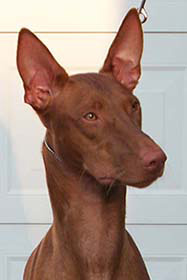 Purpose for Development of This Breed: Pharaoh hounds were bred specifically as rabbit hunters capable of hunting for long hours over rough terrain. They are known as Kelb tal-Fenek, which literally means "rabbit dog" in their country of origin, Malta. Pharaoh Hounds hunted independently and usually in braces or trios, so it was important that they be very pack-oriented in addition to having individual hunting keenness.
Purpose for Development of This Breed: Pharaoh hounds were bred specifically as rabbit hunters capable of hunting for long hours over rough terrain. They are known as Kelb tal-Fenek, which literally means "rabbit dog" in their country of origin, Malta. Pharaoh Hounds hunted independently and usually in braces or trios, so it was important that they be very pack-oriented in addition to having individual hunting keenness.
Breed's First Official Recognition: Pharaoh hounds were first imported to Europe in the 1930's. It wasn't until 1967 that they arrived in the U.S., however. They were accepted into the AKC's Miscellaneous Class in 1973 and into the Hound Group in 1984.
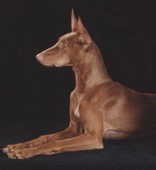 Names of the First Registered Dogs/Kennels & Other Noteworthy Dogs Within the Breed: The first and most influential kennels after the breed came to mainland Europe were Merymut and Twinley. Most kennels world-wide descend from those lines to this day. There have been many very different but very noteworthy American and Scandinavian breeders and individual dogs over the breed's past almost 30 years of recognition.
Names of the First Registered Dogs/Kennels & Other Noteworthy Dogs Within the Breed: The first and most influential kennels after the breed came to mainland Europe were Merymut and Twinley. Most kennels world-wide descend from those lines to this day. There have been many very different but very noteworthy American and Scandinavian breeders and individual dogs over the breed's past almost 30 years of recognition.
Breed Club(s) Recognize This Breed and Classification:Pharaoh Hounds are recognized almost world-wide by individual countries' kennel clubs, however, the AKC and FCI are the largest registering bodies for them. They are in the AKC and UKC Hound Groups and, overseas, are in FCI Group 5 (Spitz and Primitive Types
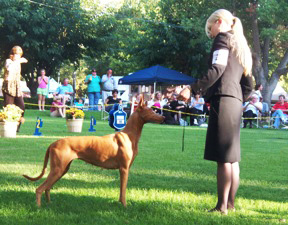 Conformation Standards:The Pharaoh Hound's appearance is unique and striking. At first glance, the breed should exude a look of elegance, speed, and power all at the same time. The breed should have an intelligent, keen, and alert expression and also exude these qualities throughout its entire demeanor and carriage. This is a medium-sized breed, ranging from 21-25 inches at the withers and weighing between 40 and 60 pounds on average, males being generally larger than females. In conformation, the Pharaoh Hound should be a structurally-sound and balanced dog above all else. It should not be overdone or exaggerated in any way physically.
Conformation Standards:The Pharaoh Hound's appearance is unique and striking. At first glance, the breed should exude a look of elegance, speed, and power all at the same time. The breed should have an intelligent, keen, and alert expression and also exude these qualities throughout its entire demeanor and carriage. This is a medium-sized breed, ranging from 21-25 inches at the withers and weighing between 40 and 60 pounds on average, males being generally larger than females. In conformation, the Pharaoh Hound should be a structurally-sound and balanced dog above all else. It should not be overdone or exaggerated in any way physically.
It's purpose was as a hardy, athletic, and proficient hunter capable of long hunts over rough/unforgiving terrain, and every aspect of the breed's appearance should support that purpose. For example, the shoulders should be well-set on and laid back and in balance to the length and return of the upper arm. The bones of the rear (the femur, tibia/fibula, and hock) should all be in balance with each other, and furthermore, be balanced in overall angulation to the front. The dog should stand well over its front with rear set slightly behind the ischium (point of buttocks) in repose. 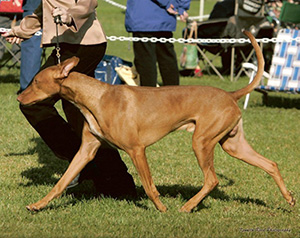 It should not stand with rear up underneath its pelvis, or too far behind the ischium, which would indicate a lack of, or excess of, angulation respectively. The topline should be solid and level (save a very slight barely detectable arch over the loin), and the well-muscled neck is set on smoothly and well in front of the shoulders and held well in front of the entire front assembly (not directly above it), with no wrinkling over the shoulders/withers, when in repose. The neck should have a slight but powerful arch naturally, and be long enough so that the jaws of the dog can easily reach the ground when standing or in motion, but the neck should not concave in the back nor bulge in the front.
It should not stand with rear up underneath its pelvis, or too far behind the ischium, which would indicate a lack of, or excess of, angulation respectively. The topline should be solid and level (save a very slight barely detectable arch over the loin), and the well-muscled neck is set on smoothly and well in front of the shoulders and held well in front of the entire front assembly (not directly above it), with no wrinkling over the shoulders/withers, when in repose. The neck should have a slight but powerful arch naturally, and be long enough so that the jaws of the dog can easily reach the ground when standing or in motion, but the neck should not concave in the back nor bulge in the front.
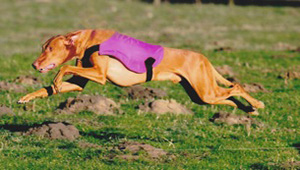 In profile, the breed is slightly longer than it is tall when measured from point of sternum to point of buttocks as compared to the measurement from top of withers to the ground. It should not appear overly rectangular, nor should it be square - it is just slightly off-square. Again, bone size and body mass must be both powerful AND elegant at the same time, and neither to excess. When trotting naturally, they should cover ground efficiently, cleanly, and effortlessly, with balanced contribution of movement from both the front and rear assemblies, and with no exaggerated extra motion (such as hackney-type lift, rotating pasterns, or over-reaching rear strides). The topline should remain strong and level as they gait, the same as when they stand. The head and neck should be held fairly high and comfortably/naturally in front of the dog when moving, the same as when standing.
In profile, the breed is slightly longer than it is tall when measured from point of sternum to point of buttocks as compared to the measurement from top of withers to the ground. It should not appear overly rectangular, nor should it be square - it is just slightly off-square. Again, bone size and body mass must be both powerful AND elegant at the same time, and neither to excess. When trotting naturally, they should cover ground efficiently, cleanly, and effortlessly, with balanced contribution of movement from both the front and rear assemblies, and with no exaggerated extra motion (such as hackney-type lift, rotating pasterns, or over-reaching rear strides). The topline should remain strong and level as they gait, the same as when they stand. The head and neck should be held fairly high and comfortably/naturally in front of the dog when moving, the same as when standing.
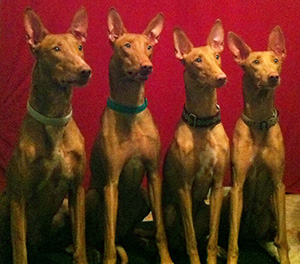 The Pharaoh's coat is short and tight and comes in various shades of red, ranging from a very light reddened-tan to a rich, deep chestnut, and all shades in between. The eyes, nose, lips, pads, toenails, and whiskers should all match the color of the coat. Most Pharaohs have at least some white markings on them, but some Pharaohs are solid red - both appropriately marked and solid-colored dogs are acceptable and neither is preferable. The following white markings are allowed by the standard: a "star" on the chest, a bit on the toes, a small white snip on the centerline of the face, and on the tip of the tail. White markings on the sides or back, or back of neck, are a disqualification.
The Pharaoh's coat is short and tight and comes in various shades of red, ranging from a very light reddened-tan to a rich, deep chestnut, and all shades in between. The eyes, nose, lips, pads, toenails, and whiskers should all match the color of the coat. Most Pharaohs have at least some white markings on them, but some Pharaohs are solid red - both appropriately marked and solid-colored dogs are acceptable and neither is preferable. The following white markings are allowed by the standard: a "star" on the chest, a bit on the toes, a small white snip on the centerline of the face, and on the tip of the tail. White markings on the sides or back, or back of neck, are a disqualification.
Some other distinguishing characteristics of the breed are, of course, the large upright ears, the long whip-like tail, and the strong jaws filled with a set of large teeth. Additionally, the breed smiles and "blushes" naturally. When they are excited, embarrassed, or sometimes even when they're dreaming, the nose leather, eye rims, and inside of the ears turns a deep rosy color.
From the AKC Pharaoh Hound Standard: "Intelligent, friendly, affectionate and playful. Alert and active. Very fast with a marked keenness for hunting, both by sight and scent."
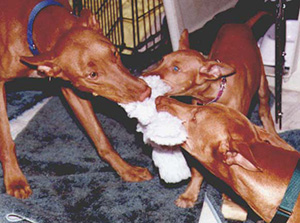 General Temperament Pharaoh Hounds are as unique in temperament as they are in appearance and history. They are playful and loving, yet dignified and self-contained. They are extremely intelligent and learn at an incredible rate. To their people, they are lovingly devoted, but in a different way than most breeds--they are very catlike in their affection, in that they are affectionate, and they do love you, but they have their own agenda to keep in mind as well. With strangers they can tend to be somewhat stand-offish and aloof at first, the females more so than the males, but many are extremely outgoing. They are very intuitive and excellent judges of character.
General Temperament Pharaoh Hounds are as unique in temperament as they are in appearance and history. They are playful and loving, yet dignified and self-contained. They are extremely intelligent and learn at an incredible rate. To their people, they are lovingly devoted, but in a different way than most breeds--they are very catlike in their affection, in that they are affectionate, and they do love you, but they have their own agenda to keep in mind as well. With strangers they can tend to be somewhat stand-offish and aloof at first, the females more so than the males, but many are extremely outgoing. They are very intuitive and excellent judges of character.
Pharaohs tend to do very well with children and other pets if introduced at a young age. They are extremely pack-oriented and non-aggressive by nature. They are true entertainers! They love to make their owners laugh at their hilarious antics. Pharaohs also seem to "play" their way through life--everything is a potential game. If they are bored, they will create their own fun!
These fun-loving hounds are also so smart that they have the ability to think in cause and effect, and can become very manipulative with their owners or caretakers when proper rules, boundaries, and expectations and not set and consistently enforced. This can make them a challenge to live with at times, since they will always be testing their boundaries. They are a fun-loving breed which reacts adversely to traditional "compulsionary" or "militant" training methods. They can prove quite stubborn at times. We have found that positive reinforcement and operant conditioning via "clicker training" is an ideal training style for this breed when it comes to competitive venues.
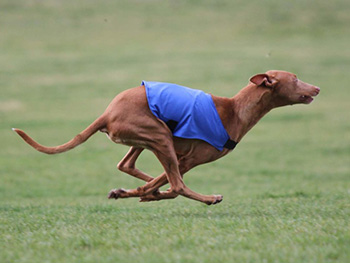 General Use, Sports, or Work For Which the Breed is Best Suited:The Pharaoh Hound is hands-down one of the most versatile breeds of dogs in existence. From a competition standpoint, they are able to be trained for, compete in, and excel in many venues. When their natural physical and mental abilities are properly harnessed, not only do they make fabulous show dogs with a great competitive drive, but Pharaohs have achieved extremely high titles and honors in agility, obedience, and rally. They also have a basic herding instinct, and, in recent years, have begun to excel in the very new venue of canine nosework. The breed does love to work, because working is (or should be) fun.
General Use, Sports, or Work For Which the Breed is Best Suited:The Pharaoh Hound is hands-down one of the most versatile breeds of dogs in existence. From a competition standpoint, they are able to be trained for, compete in, and excel in many venues. When their natural physical and mental abilities are properly harnessed, not only do they make fabulous show dogs with a great competitive drive, but Pharaohs have achieved extremely high titles and honors in agility, obedience, and rally. They also have a basic herding instinct, and, in recent years, have begun to excel in the very new venue of canine nosework. The breed does love to work, because working is (or should be) fun. 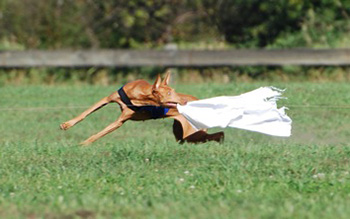 They love to be mentally and physically challenged, and are smart enough to understand specific aspects of competition also. Combine that with what should be sound and balanced structure, and they’re fully capable of almost any task.
They love to be mentally and physically challenged, and are smart enough to understand specific aspects of competition also. Combine that with what should be sound and balanced structure, and they’re fully capable of almost any task.
The breed's passion tends to be lure coursing and racing events. Very little (and usually no) training is required for lure coursing - it is all natural instinct that causes them to chase and "hunt" the lure. It is always amazing to watch the breed's natural athleticism combine with its keen hunting mentality on the field. Pharaohs will work together (even ones who have never met prior to the course) to hunt and catch the lure. This again, is pure instinct.
Breed Avoidances - Activities for Which the Breed is Not as Well Suited: Physically, there is very little that the breed is incapable of doing. However, there are a few things that they are not suitable for due to their original purpose. Obviously, these are not gun dogs or foul retrievers by nature like many dogs in the Sporting Group. The type of hunting the Pharaoh Hound was bred to do was independent rabbit hunting, as opposed to man-dependent water foul hunting assisting. They make excellent watch dogs (will alert bark readily and have keen senses so that very little is missed), however, they are not good guard or protection dogs in general. They make excellent ON-LEASH jogging/biking/hiking companions, but, due to their independent hunting instincts, are not a breed that should ever be fully trusted off-leash.
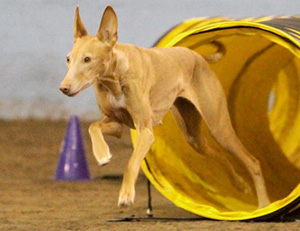 General Health of the Breed and Prone Genetic Diseases:The Pharaoh Hound is a very healthy breed as a rule. At this point in time (and for thousands of years!) they have been virtually free from the genetic problems which plague many breeds as a result of the conscious efforts made by responsible breeders to keep it that way. Reputable breeders ensure that all of their breeding stock is thoroughly health tested and cleared to the standards set forth by the Pharaoh Hound Club of America. Typically, hips are checked for dysplasia, patellas (knees) are checked for luxation, thyroid function is checked, and the eyes are checked for a myriad of disorders. There have been isolated reports of various genetic health disorders in the breed, but they are the minority. This is another reason that modern breeders hope and pray that the breed never becomes popular, thus opening the door to irreputable breeders to breed irresponsibly and ignorantly, without proper attention to structural soundness and genetic health testing.
General Health of the Breed and Prone Genetic Diseases:The Pharaoh Hound is a very healthy breed as a rule. At this point in time (and for thousands of years!) they have been virtually free from the genetic problems which plague many breeds as a result of the conscious efforts made by responsible breeders to keep it that way. Reputable breeders ensure that all of their breeding stock is thoroughly health tested and cleared to the standards set forth by the Pharaoh Hound Club of America. Typically, hips are checked for dysplasia, patellas (knees) are checked for luxation, thyroid function is checked, and the eyes are checked for a myriad of disorders. There have been isolated reports of various genetic health disorders in the breed, but they are the minority. This is another reason that modern breeders hope and pray that the breed never becomes popular, thus opening the door to irreputable breeders to breed irresponsibly and ignorantly, without proper attention to structural soundness and genetic health testing.
Pharaohs are also very tough and hearty, physically. They rarely injure themselves, even when playing wildly and fast-paced. They seem to hold up better than many breeds on the lure coursing field, too. There are, however, a few care concerns that bear knowing about. Many Pharaohs (as well as other sighthound breeds) exhibit a reaction (ranging from mild to moderate, but rarely severe) to some modern day injections, or to the carrying agents in some injections. 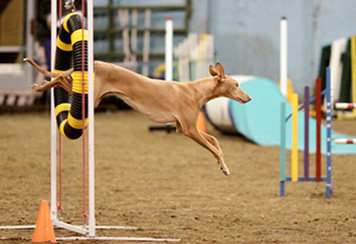 Just make sure that you and your veterinarian are aware of this fact, and monitor your Pharaoh closely for any sign of reaction after each injection. Some Pharaohs (again, the minority) have food allergies to certain ingredients found in some kibble. There doesn't seem to be a pattern or commonality as to which ingredients trigger an allergic response, however. The reported cases of food allergies are few and far between, so there is not enough information to draw a conclusion. So long as Pharaohs are fed a high-grade natural kibble, or a well-balanced raw diet, there are rarely issues.
Just make sure that you and your veterinarian are aware of this fact, and monitor your Pharaoh closely for any sign of reaction after each injection. Some Pharaohs (again, the minority) have food allergies to certain ingredients found in some kibble. There doesn't seem to be a pattern or commonality as to which ingredients trigger an allergic response, however. The reported cases of food allergies are few and far between, so there is not enough information to draw a conclusion. So long as Pharaohs are fed a high-grade natural kibble, or a well-balanced raw diet, there are rarely issues.
The average lifespan of the breed is 12-13 years, with many making it into their 14th year. Cancer in old age is not uncommon, however no more prevalent than with any other breed (including mixed breeds).
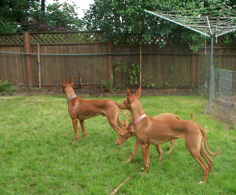 Home Environment Requirements: A decent-sized, securely-fenced yard is generally a must for this breed. The breed does best when it is allowed regular access to safely fenced open running spaces where it can really stretch out and run full-out. You don't need to have that large of a yard yourself, but you do need to ensure that the open-running requirements of the breed are met with regularity. Size of yard is not nearly as important as security of fencing. Pharaohs are very athletic and need a 5+ foot fence that is either buried or secured to the ground, as they can be jumpers (or diggers) if left unattended, therefore, it is not advisable to leave the breed outside for prolonged periods of time without supervision. Regardless of geographical region or weather, they should be primarily house dogs. Pharaohs do fine in a smaller house so long as its exercise demands are met. With proper training and exercise, they make excellent, clean, mannerly house pets.
Home Environment Requirements: A decent-sized, securely-fenced yard is generally a must for this breed. The breed does best when it is allowed regular access to safely fenced open running spaces where it can really stretch out and run full-out. You don't need to have that large of a yard yourself, but you do need to ensure that the open-running requirements of the breed are met with regularity. Size of yard is not nearly as important as security of fencing. Pharaohs are very athletic and need a 5+ foot fence that is either buried or secured to the ground, as they can be jumpers (or diggers) if left unattended, therefore, it is not advisable to leave the breed outside for prolonged periods of time without supervision. Regardless of geographical region or weather, they should be primarily house dogs. Pharaohs do fine in a smaller house so long as its exercise demands are met. With proper training and exercise, they make excellent, clean, mannerly house pets.
Compatibility With Other Animals: Pharaohs are naturally pack-oriented and do well with other dogs (though they tend to prefer the company of their own kind, or similar sighthound breeds, when given a choice). They should be non-aggressive by nature (natural temperament combined with proper socialization and training ensure this). The breed is prone to naturally smiling as pictured here (below), but this is not to be mistaken as agression. It should be noted that the breed does play differently from the average dog, with lots of teeth, snapping, snarling, etc., which can be quite scary for other breeds at times, so care must be taken in seeing that the subject of the Pharaoh's rough play is not getting too overwhelmed. Other than that, there are rarely problems. Of course, intact males of any breed must always be watched with caution when together, and Pharaohs are no exception to this rule. Another interesting note is that in a multi-breed households, the Pharaoh will usually become the top dog of the pack, especially Pharaoh bitches.
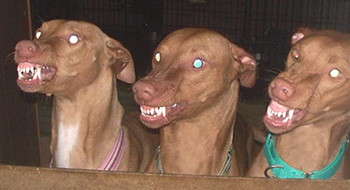 Many people own both cats and Pharaoh Hounds without issue. It is important the Pharaoh and kitty be raised together. It is your job to teach the Pharaoh to respect, and ideally, to ignore cats. Although I have heard of several Pharaohs who were introduced to cats for the first time as adults and did fine, I would be very hesitant in doing this. Likewise, I wouldn't introduce a new kitten to an adult Pharaoh who has had no prior experience living with cats. This breed has a VERY strong hunting instinct, and their natural instincts tell them that cats are prey, and prey must be hunted, chased, and killed. If the Pharaoh is raised with cats and the owner is vigilant and careful (always separating the two when they leave home, and never letting the Pharaoh get away with any sort of "chase" games with the cat) there shouldn't be problems. However, it is important to remember that instinct is still very much alive in even the most cat-friendly Pharaoh.
Many people own both cats and Pharaoh Hounds without issue. It is important the Pharaoh and kitty be raised together. It is your job to teach the Pharaoh to respect, and ideally, to ignore cats. Although I have heard of several Pharaohs who were introduced to cats for the first time as adults and did fine, I would be very hesitant in doing this. Likewise, I wouldn't introduce a new kitten to an adult Pharaoh who has had no prior experience living with cats. This breed has a VERY strong hunting instinct, and their natural instincts tell them that cats are prey, and prey must be hunted, chased, and killed. If the Pharaoh is raised with cats and the owner is vigilant and careful (always separating the two when they leave home, and never letting the Pharaoh get away with any sort of "chase" games with the cat) there shouldn't be problems. However, it is important to remember that instinct is still very much alive in even the most cat-friendly Pharaoh.
Weather Considerations:Pharaohs do not have the greatest tolerance for cold weather. They are so short haired and have so little body fat on them that they cannot be out in the cold for very long. In colder climates, a warm and protective coat or jacket is a must when they're outside, and they shouldn't be made to stay out any longer than necessary. Also, their ear tips can easily freeze in sub-zero temperatures and need to be protected with a coating of Vaseline and/or a "snood" (a fitting neck and ear warmer. I have had a few Pharaohs who just love to play in the snow, and seem to not even notice that they're freezing, but most of mine would rather hold it all day that go outside in the cold to relieve themselves. They should be housedogs primarily, but especially so in cold weather.
They tend to do much better in the heat than those breeds with heavier fat layers and thicker coats and less exposed extremities to aid in cooling. However, as with any dog, persuasions must be taken even in hot weather, and again, the breed is not suited to be left in the heat. Even in Malta, most hunting was done in the cooler nights.
Other Considerations for the Breed:Pharaoh Hounds do best when properly physically AND mentally stimulated on a regular (daily) basis. They are true athletes who love to use themselves physically, and they are also extremely intelligent and need to have something to do - be it a job or daily training or regular competitions. They enjoy the company of, and interaction with, both people and other dogs. They also enjoy interactive toys and/or chew toys (or at the very least, something appropriate to chew on to keep them mentally occupied) on a regular basis.
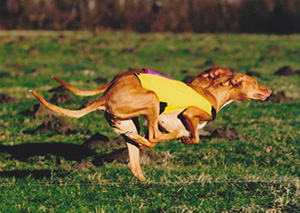 Recommendations for Locating and Choosing Responsible Breeders:The Pharaoh Hound Club of America (PHCA) keeps a list of members who adhere to the strictest health testing and dog welfare considerations. The AKC's "Breeder of Merit" program is a good indicator of which breeders are reputable in terms of health testing and involvement/success in competition events. When looking for a reputable Pharaoh Hound breeder, keep in mind that a reputable breeder will have just as many - or more - questions for you as you have for them. They will be careful to screen you (find out all about you, your family, your home, your experience, and your expectations in a potential Pharaoh Hound) before allowing you to buy or reserve a puppy or adult dog. Ideally, they will also ensure that you've had the chance to meet the breed in person and talk to not only them, but other Pharaoh owners/exhibitors/breeders about the breed prior to making the decision to add one to your family. If geography permits, they should be more than willing to have you come to their home, or meet them at a dog event (show, lure trial, etc) to meet their dogs in person. Ask what health testing they have done on their Pharaoh Hounds prior to breeding. The more OFA tests they have done, the better. Ask how many of their dogs have CHIC numbers. This number indicates that that particular dog has had all the tests recommended by the parent club (Pharaoh Hound Club of America).
Recommendations for Locating and Choosing Responsible Breeders:The Pharaoh Hound Club of America (PHCA) keeps a list of members who adhere to the strictest health testing and dog welfare considerations. The AKC's "Breeder of Merit" program is a good indicator of which breeders are reputable in terms of health testing and involvement/success in competition events. When looking for a reputable Pharaoh Hound breeder, keep in mind that a reputable breeder will have just as many - or more - questions for you as you have for them. They will be careful to screen you (find out all about you, your family, your home, your experience, and your expectations in a potential Pharaoh Hound) before allowing you to buy or reserve a puppy or adult dog. Ideally, they will also ensure that you've had the chance to meet the breed in person and talk to not only them, but other Pharaoh owners/exhibitors/breeders about the breed prior to making the decision to add one to your family. If geography permits, they should be more than willing to have you come to their home, or meet them at a dog event (show, lure trial, etc) to meet their dogs in person. Ask what health testing they have done on their Pharaoh Hounds prior to breeding. The more OFA tests they have done, the better. Ask how many of their dogs have CHIC numbers. This number indicates that that particular dog has had all the tests recommended by the parent club (Pharaoh Hound Club of America).
Ask about what titles and honors their dogs have received (if this is not evident from their website). In a versatile breed like the Pharaoh Hound, achieving a Dual Championship (meaning the dog is a Champion of Record in both the show ring and in lure coursing) should not be difficult for any decent quality Pharaoh Hound and should practically be as pre-requisite to breeding as proper health testing. 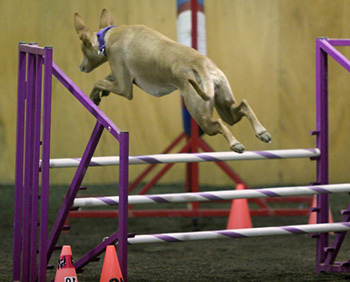 More advanced titles above and beyond basic Champion (CH), Field Champion (FC), and Dual Champion (DC) are also pluses. Steer very clear and stay far away from breeders who 1) don't health test, or b) don't show, or compete in other performance events, or c) do compete, but don't, at the very least, have basic Championships and titles on their dogs. If a breeder tells you that they don't health test because "It's a generally healthy breed so we don't need to do that," or tells you they don't show or don't have titles on their dogs because they "don't need the outside affirmation because it is clear to see that their dog(s) are beautiful and to the standard" - RUN, don't walk, away and find a breeder who does take health testing and competition titles seriously.
More advanced titles above and beyond basic Champion (CH), Field Champion (FC), and Dual Champion (DC) are also pluses. Steer very clear and stay far away from breeders who 1) don't health test, or b) don't show, or compete in other performance events, or c) do compete, but don't, at the very least, have basic Championships and titles on their dogs. If a breeder tells you that they don't health test because "It's a generally healthy breed so we don't need to do that," or tells you they don't show or don't have titles on their dogs because they "don't need the outside affirmation because it is clear to see that their dog(s) are beautiful and to the standard" - RUN, don't walk, away and find a breeder who does take health testing and competition titles seriously.
Also, before committing to buy a puppy (or adult dog) from any breeder, ask to see the contract. You will not get a dog from a reputable breeder without a detailed contract. If the breeder doesn't have a contract, search elsewhere. There should be clauses in the contract not only dictating the welfare or how the dog is to be kept on a day-to-day basis, but also what's called a "Return to Breeder" clause. This requires the return of the Pharaoh Hound to its breeder at any time throughout the dog's life if the owner cannot or does not wish to keep it. This is very key, as reputable breeders will not allow anyone to place their dogs other than themselves, since this is such a unique breed that is absolutely not suitable for many people to own. A reputable breeder has a lifetime commitment to every dog they produce.
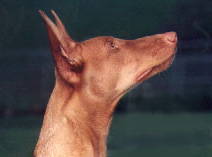 If you are buying a pet quality Pharaoh Hound, a reputable breeder should always have a mandatory spay/neuter clause in their contract, and, they will sell all pet puppies on an "AKC Limited Registration." This registration still allows full participation in ALL AKC competitive events except for conformation (showing), but protects the breeder's bloodlines in that, no offspring from an AKC Limited Registration dog can be registered, ensuring that irreputable breeding should not occur. Finally, with very few exceptions, a reputable breeder should microchip all of their puppies before they leave for their new homes, and provide the buyer with proof of microchipping. Microchipping is also required to be in good standing with the PHCA.
If you are buying a pet quality Pharaoh Hound, a reputable breeder should always have a mandatory spay/neuter clause in their contract, and, they will sell all pet puppies on an "AKC Limited Registration." This registration still allows full participation in ALL AKC competitive events except for conformation (showing), but protects the breeder's bloodlines in that, no offspring from an AKC Limited Registration dog can be registered, ensuring that irreputable breeding should not occur. Finally, with very few exceptions, a reputable breeder should microchip all of their puppies before they leave for their new homes, and provide the buyer with proof of microchipping. Microchipping is also required to be in good standing with the PHCA.
About the Author, Emily Kerridge
Text Placeholder....


